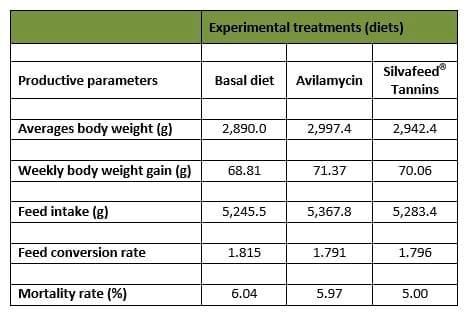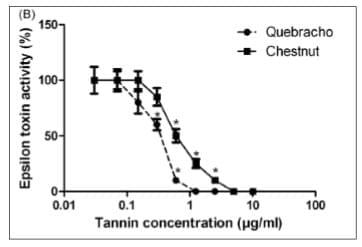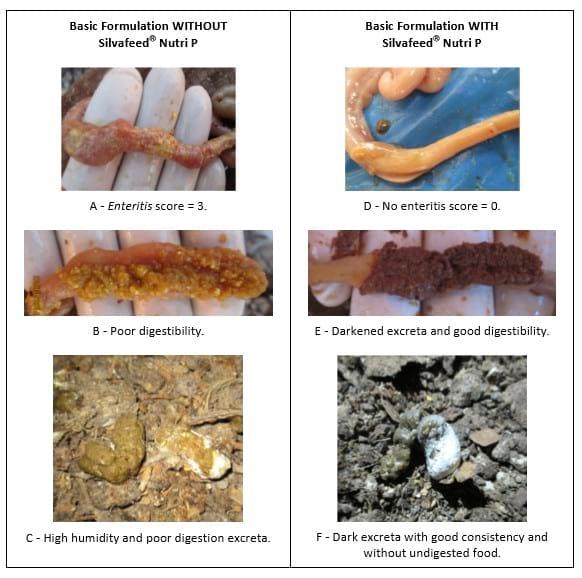Use of Plant Extracts Rich in Tannic Acid and Polyphenols as Enhancing Agents of Poultry Intestinal Quality
The use of antibiotics as feed additives in animal production is being reviewed by several countries and new alternatives need to be used. Both polyphenols and tannic acids from plant extracts appear to be effective options to enhance the intestinal health of poultry.
When looking for an alternative, the tendency is to compare the results to the standard obtained for decades with the use of antibiotics. However, it is necessary to combine different products such as essential oils, prebiotics and organic acids for example, to achieve an adequate response to increased field challenges and new market requirements.
Although the therapeutic use of antibiotics is not going to stop, the use of plant extracts rich in polyphenols and tannic acids have demonstrated an effective action on pathogenic bacteria such as Clostridium perfringens and a significant intestinal quality improvement.
Keywords: Tannins, tannic acid, poultry, polyphenols, broiler, antibiotic free, intestinal health, Clostridium.



The use of polyphenol-based extracts was evaluated in a population of 3.0 million birds during a 21 day treatment. The study was conducted in vivo in cooperation with Southern Brazilian farmers. Silvafeed® Nutri P was used as plant extract rich in tannic acid and polyphenols for the trial and was dosed at 1kg per tonne of feed. The addition of Silvafeed® Nutri P to the standard diet normally used by the company (with AGPs) showed positive effects in the reduction of Enteritis in poultry. Furthermore, more consistent excreta with noticeable improvement of intestinal health were obtained compared to the control birds (Figure 3).


Do we have any experimental data on broilers and layers to substantially proof our claim with regards to performance, FCR and mortality?
Please enlighten me on the active ingredient in turmeric and garlic. How much active ingredient is available in one 1gm or kilo of raw material. At what dose it is preventing the bacterial growth and at what dose it is killing 100%?
Which lab tests these facts? I will follow up.
Broiler producers are not missing antibiotic growth promoters. The annual genetic improvement by breeders all in all out rearing and improved biosecurity is helping a lot. Broiler flocks do get into problems due to slips in management protocols.
these are being exploited by quacks who suggest plant extractions and plant products as a whole.
In india turmeric and garlic are being used directly in feed. some companies have commercialised them.
This is quackery.
we do not know the active ingredient in it.
we have not researched on the dosage evaluating the safety, potency and the side effects.
handling of these things are not hygienic. small farmers carry them in used sacs, grind it some way mix it in some quantity (nobody knows how much) and expect it to work. Some companies are trying to give legitimacy by conducting field trials. nobody publishes the trials which yield poor results. some positive results appear randomly and they are highlighted.
I personally feel that these things were used few thousand years ago due to lack of alternatives.
It is better that the scientific and knowledgeable society work on the active ingredient, potency and safety.
Dear Dr, Chakraborty, thanks to share your experience with tannic acid in livestocks.
My experience, as I shared with your, is in the field.
In my concept, there is a big difference to talk about sorghum tannins or the other plants tannins, related to extracted polyphenols from plants extracts. It is necessary a industrial process to get different compounds. There are hundreds or thousands compounds classified under the umbrella "Tannin".
The sorghum experience, we all know, with its high concentration in condensed tannin is a old concept that everybody learn in the university and became for a long time as a negative pattern in therms of poultry results.
Otherwise, the polyphenols extract from the other group of compounds will depende on: 1. Plant specie, 2. Geografic region, 3. Active compound, 4. Plant age, 5. Extraction methodology, 6. dosage, etc.
In the case of Nutri P/SilvaTeam, there are based on hydrolyzable tannins (ellagitaninn, gallotannin, etc), not just condensed tannins (procyanidinic or profisetinidin) like you sorghum, quebracho, etc. Your comment, I hope, is under your experience with condensed tannins.
Hydrolysable tannins are hydrolysed by acids or bases to produce carbohydrate or phenolic acids, like digallic acid or gallic acid, for example.
Condensed tannins like proanthocyanidins are polymeric flavonoids with a more complex heterocyclic ring system, and have a strong protein bind capacity, as you cited.
Your inputs are completely right over the condensed tannins concept.
My experience is that under field challenge conditions in big companies, with the same nutriotional formulation and comparing the results in a, for example, 3 million bird/month, the intestinal integrity was much better, based on necropsy standards (0-3 scores) with lots of flocks with 10% or 14% better performance results, than the flocks without the NutriP/Silvafeed.
Otherwise, the foot pad lesions reduced more than 10% due the better excreta consistency and, consequentelly, much better litter conditions.
Again, it was my field experience. My experience with some trials in University`s experimental facilities, the results were not so good, due the lack of callenge. Like we can observe in lots of scientifc papers about growh promoters, probiotics, etc (50% positive, 50% negative in experimental conditions).
I agree with Dr. Christopher. We need to check. There are lots of opinions, all valids, but each situation is different when we talk about animal production.
Could you please share with us, your practical experiences with tannins? It was just with sorghum or any other compounds too?
Thanks again to enrich this forum. Very instructive.
Dear All, Dr. Balamurugan, Dr.David, Dr. Chandra, Dr. Chakraborty, Dr. Ponebsek.
Thanks for your questions and inputs. I`m not a nutritionist or a veterinarian specialized in pharmacology or toxicology. May background is on poultry intestinal health.
Besides all scientific papers, the best way to be sure about the tannins action is using them, facing intestinal disorders in the field. My experience was very positive on that, using big customers as reference.
Bellow I would like to share my opinion and SilvaTeam informations about your questions. I`m glad to share it with you and hope we can learn more about this new and very exciting assumption. Now a day, there are hundreds publications about it on internet.
“My qestion is that how could anyone proclaim TANIC ACID in feed or any polyphenol is benificial to poultry intentine?”
The answer could be: none!
1) Tannic acid is a defined molecule, thus much more easy to define it´s activity. NutriP is rich in Tannic acid, but also other components derivated from its extraction, as castalgine and other components present in the raw material from which we make the extraction.
2) Polyphenol is a huge family of molecules, include lignin, and many other components without bacteriostatic or antibacterial activity. Similar should be talking about Vitamins and expect all of them to have antioxidant properties.
Once one give precision to a definition, then effects and activities could be more clarified.
Toshitsugu et al at the Biological Pharmaceutical Bulletin. 27 (12) 2004 said: “Recently, many biochemical and epidemiologic studies have revealed that polyphenols of various foods and herbs are beneficial to human health, and some extracts of polyphenols-rich plants, such as green tea and grape seed, have been applied to functional foods or supplements. The potent biological activities of green tea polyphenols in, for example, cancer and cardiovascular disease prevention (Mukhtar H., Ahmad N., 2000), have been attracting scientists in medicinal and pharmaceutical fields. Tea polyphenols were also shown to have antibacterial (Hara Y., Ishigami T, 1989; Toda M. 1989, Toda M. Okubo S., Ikigai H., Shimamura T., 1990), antiviral (Nakayama M., et al, 1993) and antifungical activities (Okubo S., Toda M., Hara Y., Shimamura T., 1993) in addition to their inhibitory effects on exotoxins (Ikigai H. et al 1993).
Johnson, B.J. et al, 2008 cited the proanthocinidins capacity to bind LPS (lipopolysacarides) like that find in Clostridium perfringens exotoxins.
Dr. Mariano Myakawa et al. 2016 presented the potencial of Chestnut and Quebracho extracts to inhibit in vitro alpha and epsilon toxin activity at relatively low tannin concentration.
In the past there was very few studies about the polyphenols effect on animal production. Today, there are lots of scientific studies showing different activities. The main point to consider is that under the general therm “tannins” concept there are hundreds of different substances with different characteristics. Each one, depending on different factors like: plant, active compound, extraction method, etc, can act as an anti-nutritional factor or as a benefit product to animals. These types of polyphenols, such as hydrolysable and condensed tannins, are widely distributed in the plant kingdom and have the potential to be functional material.
Among the mechanism of action described until know:
1. Regulating the intestinal microbiota (Chen, Y.2012)
2. Reducing the immunological stress (antioxidant effect - Gulcin et al., 2010; Makino et al., 2011; Cai et al, 2005; Yilmaz et al., 2004; Leopoldini et al., 2011; Andrade et al., 2005, Tarabra, E. and Hernández, E. 2010)
3. Antispasmodic effect (Budriesi, et al, 2010)
4. Bacterial inhibition (Salmonella typhimurium – Costabile,A. et al, 2011, Massi, P. et al,2007 ; Clostridium perfringens – Elizondo, A.M. et al, 2010)
5. Toxin inhibition (Elizondo, A.M. et al, 2010)
6. Antiviral activity (Lupini, C. et al. 2006)
“ Please help me to understand how exactly these tannic extract could work, to improve on the intestinal performance. Do they do that by improving on the on intestinal lining or by anti bacterial effect.”
The tannic acids we refer to improve intestinal performance through different mode of actions, not just only one. They do act regulating the peristalsis in the intestinal tract, avoiding fast transit problems (Budriesi, et al, 2010; Micucci, M. et al, 2014) as well as their effect on different pathogens in the intestine, increasing general feed digestion conditions (Biagi, G. et al, 2010) related to "Effect of tannins on growth performance and intestinal ecosystem in weaned piglets". Other files regarding this effect are available on request. The other factor is the antioxidant effect, avoiding certain pathogens growth, together with the quelation of certain metals essential for pathogens growth.( Gulcin et al., 2010; Makino et al., 2011; Cai et al, 2005; Yilmaz et al., 2004; Leopoldini et al., 2011; Andrade et al., 2005, Tarabra, E. and Hernández, E. 2010)
“Tannins also has anti nutritional factors. How it is managed for improving the performance.”
That is also true, and depending on the type of tannin (condensed or hydrolysable) and its concentration, adverse effects could be observed. Negative effects are related to protein digestion and complete feed digestibility. No negative effect have been observed for the tannins we combine for NutriP either ByPro, enven at dosages 10 times higher than the recommended ones where dosages up to 5% of chestnut extract concentration in the feed do not generate adverse effects (Hervás, G. et al, 2003. Nutri P is recommended to poultry feed at the dosage of 0,5 to 1,0 kg/metric ton and there are not observed any impact on feed consumption or anti nutritional effect, just the opposite.
“De-taninfication in commercial scale is costly process.Even after that it has to seen the effect on performance of laying birds at different level of dosages”
Nutri P/ENC can be considered a helping hand in layer hen production, considering liability and the egg laying rate, by improving the digestion and absortion of nutrients (Reddy, K and Pradeep, K. 2012).
Yes, depending on the typpe of tannin, as said, adverse effects could be observed, mainly in protein digestion. Tannin components are like fruits: very different between themselves, even when all are from the same family. But bananas could not be compared with apples. On the other side, it is not the same to talk about native tannins than comparing them with added tannins. A full analysis of tannins´digestion is being analyzed by one of the teams with more knowledge on tannins in the world (Hagerman, A. et al., 1992).
“ It becomes beyond my convincing capacity to note that Tannic acid has a positive impact on nutritional ground as the component has always been recognized to be the anti -nutritional since beginning .Please give details of the pharmodynamics of same to improve intestinal function.”
Since the beginning (about 2500 million years before), tannins were develloped by plants to protect themselves and hervibores co-evoluted with them, develloping a metabolical system to take profit of these substances. Ancienne gallenic medicine, as well as many Oriental cultures use vegetable extracts to treat illnesses and also solve intestinal disorders and patogenic problems. When intensification of livestock happened, nutricionists focus their requirement on key factors as proteins, fats, carbohydrates, excluding minor components that were natural ingredients in animals diet. Tannins become negative due to their interaction with proteins and the concept of protein digestibility reduction, as said in the point above. Further research, starting on the 2000 shows mainly positive effect of tannins, in several aspects, as antibacterial, antioxidant, etc.
Considering different types of tannins, condensed ones have the possibility to bind selective different types of proteins, being in this way bacteriostatic elements, and afterwards excreted (recovered in the feces) while hydrolysable tannins are metabolized and derivate in gallic acid/ellagic acid (potent antioxidants), plus sugar.(Garcia-Muñoz; Vaillant, F.,2014)
“Aren´t Quebracho tannins antinutritional. In chemical structure are similar like tannins found in sorghum or in rape seed? We were taught that such tannins are antinutritional?”
As showed in the references above, quebracho tannin antinutritional effect depends on the dosage, as most of the components you can include in a diet, in this case, with much more wider safety range. Rusdi (2004) shows that 5% quebracho tannin content in a feed formula can cause intake depression, what is 50 times higher than the usual recommended usage. Other references are available on demand.
Dear Dr Abdulla Ahmad Tahir, thanks for your request. Actually, the product related in the publication is ENC or Nutri P (commercial name in Brazil). This product is based, basically, on two plant extracts: Quebracho and Chestnut both with high tannin and polyphenols concentration - . Tannins are wide in all plants but the diference is related to the hability to extract them from the plant and the caracteristics of each coumpound (condensed tannins like procyanidinics or hydrolizable like galotannin, etc). So, all plants you related have some tannins concentration, mainly black tea, that have much more data on it, but unfortunatelly I don`t have specific information about these plants. If you want more details about Nutri P or ENC effect on layer performance and intestinal health, I will be glad to send you by email. Please, contact us here. Best regards! Lancini




.jpg&w=3840&q=75)











.jpg&w=3840&q=75)